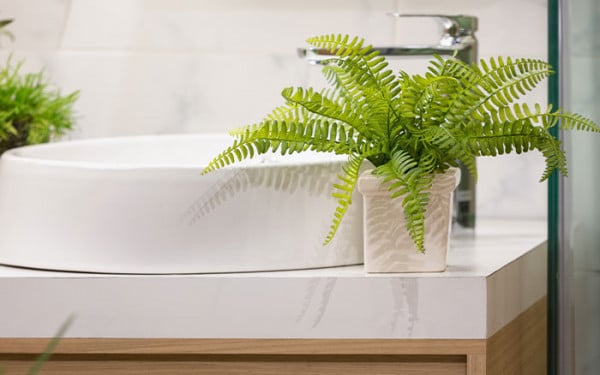The benefits of indoor gardening have been well documented, you can see many of the reasons in my book My Houseplant Changed My Life. Another incredible ability of some houseplants is that they can act as mould-busters. So which houseplants can prevent mould in the home?
How is mould caused?
High levels of humidity and heat can have the unpleasant result of mould. Due to the conditions, this is most likely to happen in the bathroom or maybe the kitchen.
To reduce the likelihood of mould forming, it’s important to ensure the space is well ventilated. You can do this by opening windows and doors to allow air movement, especially after baths or showers. In addition, turn on the ventilation fan in your bathroom whenever the space is in use.
Even when doing this, keep an eye out for mould as it can often creep into spaces that you may miss. Behind toilets or sinks are common spaces where mould is found.
Plants that help prevent mould
Using houseplants in rooms prone to mould is a natural way of controlling humidity levels. This is due to the plants absorbing moisture through the leaves.
This is a win-win, because not only will you have reduced the risk of mould, but you’ll have stunning greenery to enjoy in your home.
So, which houseplants will help to prevent mould?

Hedera helix (English ivy)
The trailing foliage of this evergreen looks striking when positioned in a hanging basket where the leaves cascade out over the pot. It’ll grow happily with plenty of bright, indirect light with moist but well-drained soil. Water regularly, checking the top inch of soil and wait until it is dry to water again.
In terms of humidity, English ivy prefers medium to high humidity, meaning it will happily grow in a bathroom or kitchen.
Hedera helix is within the top houseplants for purifying air by filtering out toxic chemicals. From a controlled experiment, it was found that it reduced levels of formaldehyde, benzene, and trichloroethylene. Not only this, but research has showed that it can help combat mould in the home.

Dracaena trifasciata (snake plant)
Next is a houseplant that’s as tough as nails and is low-maintenance so won’t demand much from you. Their ease means they’re a great houseplant for beginners. They are incredibly tolerant in terms of their position, but prefer a sunny position. Snake plants are able to tolerate being in humid or dry rooms in the house.
Not only are they said to help prevent mould in the home, but they may help reduce the damaging health effects of trichloroethylene. This is a chemical compound found in cleaning products that cause headaches, dizziness, and nausea. In addition to this, they also continue to remove carbon dioxide and produce oxygen during night-time.

Spathiphyllum (peace lily)
Peace lilies are a hugely popular houseplant, and for good reason. They bring a brightness to the space with the white bracts that contrast beautifully with the dark glossy foliage. Perfect for warm, humid environments, they will appreciate watering when the top of the soil dries out. Their love of humid spaces makes them great for placing in areas prone to mould.
The glossy foliage doesn’t just look great, they also are able to extract high levels of benzene, formaldehyde, trichloroethylene, and ammonia from the atmosphere and giving you plenty of oxygen instead.

Palms
There are a variety of palms that make fantastic houseplants. Among them is Dypsis lutescens (areca palm), Phoenix robelenii (dwarf date palm), Rhapis exelsa (broadleaf lady palm) and Chamaedorea elegans (parlour palm). They are great for controlling humidity levels and as mould preventatives. They do this by absorbing the excess moisture into their leaves.
Studies into air purification showed that palms help to rid formaldehyde and xylene from the atmosphere, making them a great addition to the home.
The structure of palms adds elegance to the space, whether in a dining room, living room, or adding some greenery to bathrooms. Due to their height, they can be a great houseplant to replace Christmas trees after the festive period is over.


Leave A Comment